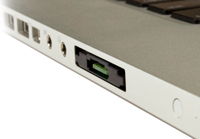MBP Shootout: eSATA adapter cards


Chambers reviewed 3 cards: Sonnet's Tempo SATA Edge card and 2-port Tempo SATA Pro, and Other World Computing's Slim ExpressCard to eSATA Adapter.
Two of the cards offer a new look to these adapters, an "edge" or "slim" design that sits flush against the side of the MacBook Pro case. This is a very nice option for customers only needing one port. The older style cards stuck out quite a bit, even the ones with only a single port, and I always remove mine before putting my MBP in a sleeve.
The OWC adapter is based on the new JMicron JMB360 chipset, which appears to fix a number of the difficulties that have bothered previous eSATA cards: it doesn't require any additional drivers or software, and you can boot from it with any MBP that has an Intel Core 2 Duo processor or better. (Sadly, that excludes my first-gen MBP, sniff ...) It also supports hot swapping, meaning you can remove a drive without shutting down, which was a problem with some of the cards on the market.
Chambers points out that potential buyers of an MBP who work with demanding digital content applications, such as video, should take a look at eSATA. It's much faster than FireWire 800 and USB 2.0.
Performance with any of these cards is far better than with Firewire 800, something which should be kept in mind when purchasing a MacBook Pro, since only the 17" model has the ExpressCard/34 slot (certain prior generation 15" models also have the ExpressCard/34 slot).
Still, all of these cards are somewhat disappointing, because their best performance is only 45 - 70 percent of what can be had with the fastest peripherals on the Mac Pro. This is the fault of the MacBook Pro with its low bandwidth ExpressCard/34 slot.
I am sorry to see the ExpressCard/34 slot removed from the 15-inch MacBook Pros, although I understand the positioning.
At the same time, there have been plenty of trouble and disappointment with eSATA cards and drives from multiple vendors following the introduction of ExpressCard/34 on the first MacBook Pro. First of all, to my knowledge, none of the first-gen Core Duo-based MBPs could boot from the connected eSATA drives with an eSATA card, a capability that was assumed from Mac external storage devices (or at least I certainly assumed it).
In addition, many adapters and drivers presented a very non-Mac user experience. For example, adapters based on Silicon Image's SiI3132 chipset require users to dismount the card using a Finder Menubar icon even when all mounted volumes on the external drive have been ejected (this OEM adapter was offered by various storage vendors). Worse, many drivers broke with the release of Mac OS X 10.6 Snow Leopard.
The excellent Accelerate Your Mac site has tracked this issue from the beginning and offers a wide range of eSATA reviews. In Feb., the site pointed to Silicon Image's release of updated, "beta" BASE drivers that are compatible with both 32-bit and 64-bit Snow Leopard installs.
I have installed these drivers and they work on my machine (again, pointing out that my Mac can't boot from the eSATA drive).
SI was quick to remind customers that as an OEM vendor, it doesn't support these drivers in a note to end users on its software download page:
Silicon Image designs and develops chips for manufacturers. These manufacturers develop their own drivers, firmware and software for their boards. Silicon Image does not have information or access to the Drivers, Software or boards that these manufacturers create and sell. We typically assist these manufacturers when they have problems with our chips. End-Users should contact product manufacturer of the board for technical support.
Of course, few of the companies selling these cards were developing drivers, firmware or software. They just sold them with the SI drivers, which then broke again and again.
The latest generation of eSATA cards from most vendors have fixed the issues. However, before purchasing any of them, make sure that they can boot from your MacBook Pro model. In addition, I suggest that the purchase of external storage offering a range of bootable connectivity interfaces beyond eSATA, such as USB 2.0 and FireWire 800. Just in case.